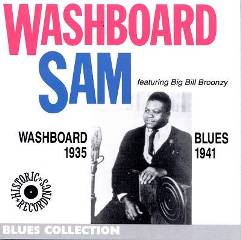Washboard Sam - Washboard Blues 1935-1941 (1997)
Washboard Sam - Washboard Blues 1935-1941 (1997)

1 Mama Don't Allow, No. 1 2 I'm a Prowlin' Groundhog 3 Give Me Lovin' 4 Oh, Red! 5 Swing Cats Swing 6 Low Down Woman 7 Big Boat 8 Second Story Man 9 Down at the Old Village Store 10 It's Too Late Now 11 Bucket's Got a Hole In It 12 Policy Writer's Blues 13 Diggin' My Potatoes 14 Jersey Cow Blues 15 She Fooled Me 16 I'm Going to St. Louis 17 Little Leg Woman 18 I'm Not the Lad 19 Flying Crow Blues 20 Gonna Hit the Highway Washboard Sam - Vocals, Washboard Joshua Altheimer - Piano Buster Bennett - Sax (Alto) Big Bill Broonzy - Guitar Blind John Davis - Piano Simeon Henry - Piano Black Bob Hudson - Piano Louie Lasky - Guitar Horace Malcolm - Piano Memphis Slim - Piano Herb Morand - Trumpet Arnett Nelson – Clarinet
Washboard Blues 1935-1941 is an excellent overview of Washboard Sam's great tracks, containing all the highlights from his peak years. It's ideal for the curious, or listeners who don't want to dig as deep as Document's multi-volume Complete Recorded Works series. ---Thom Owens, Rovi
Hokum blues artist Washboard Sam, real name Robert Brown, was born in Walnut Ridge, Arkansas, in 1910. He was the illegitimate son of Frank Broonzy, father of Big Bill Broonzy, making him a half brother to the older blues legend. As well as playing the washboard, he was a fine vocalist and songwriter whose childhood was spent working as a farmhand. He moved to Memphis when he was just into his teens and began playing the street corners in the company of Sleepy John Estes and Hammie Nixon. When he was 22 years old he moved to Chicago and linked up with his half brother, playing the clubs together, with Washboard Sam eventually supporting Broonzy on some of his Bluebird recordings. He was soon supporting a number of artists, including Memphis Slim, and by 1935 he was recording in his own right, with roles reversed as Big Bill Broonzy supported him. For the rest of that decade and until the mid 1940’s his records sold well and he was much in demand. However as music tastes changed and the new electric blues developed, his brand of hokum became out of fashion and he virtually retired from the music business in the early 1950’s. He made a brief return in the 1960’s during the folk/blues revival period, playing mainly in Chicago and even recording again in 1964. However his health was already declining by then and he died of heart disease in Chicago in 1966 aged 56. --- thebluestrail.com
download: uploaded yandex 4shared mediafire solidfiles mega zalivalka filecloudio anonfiles oboom








